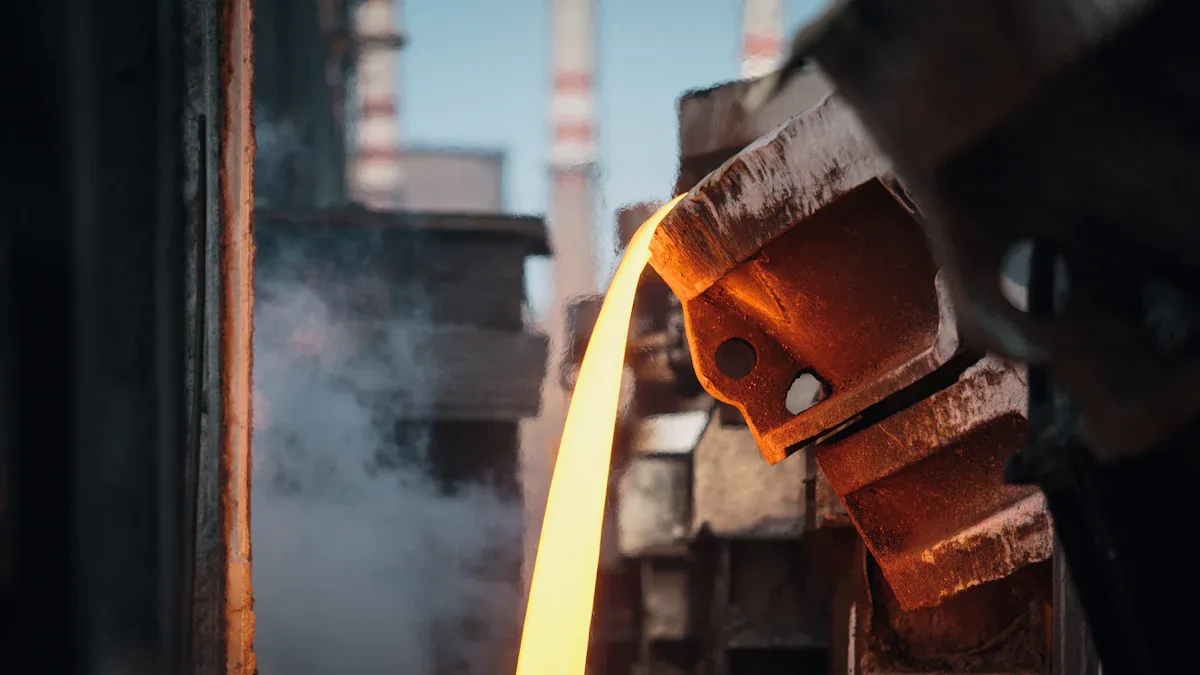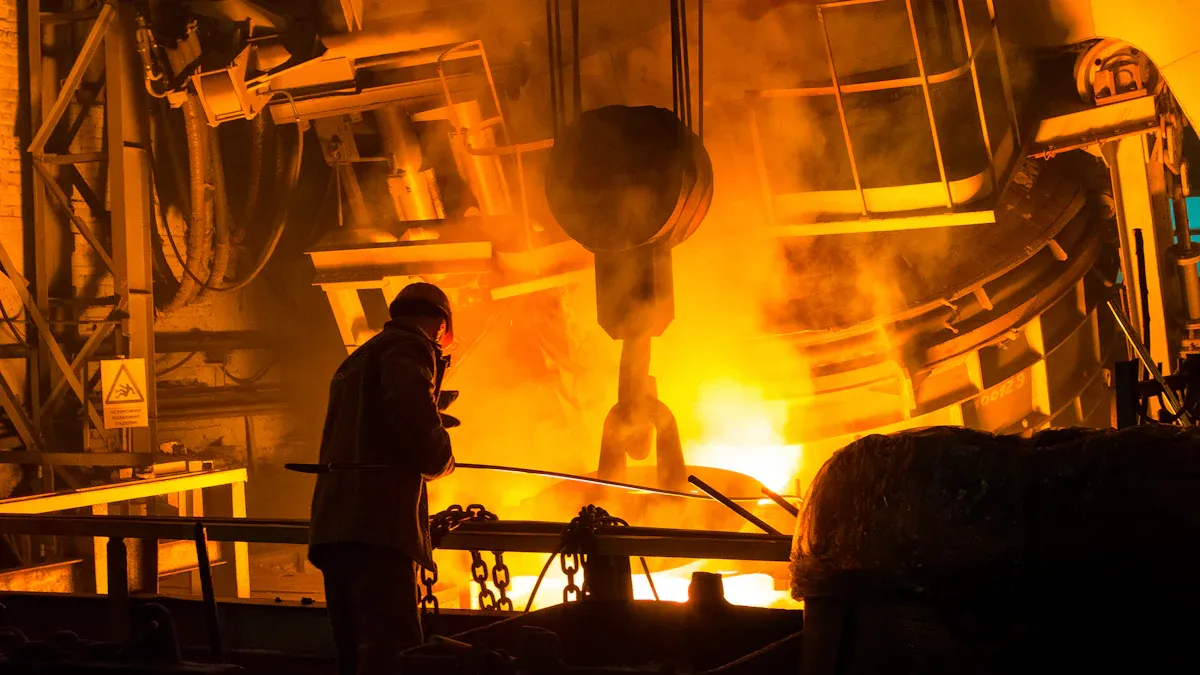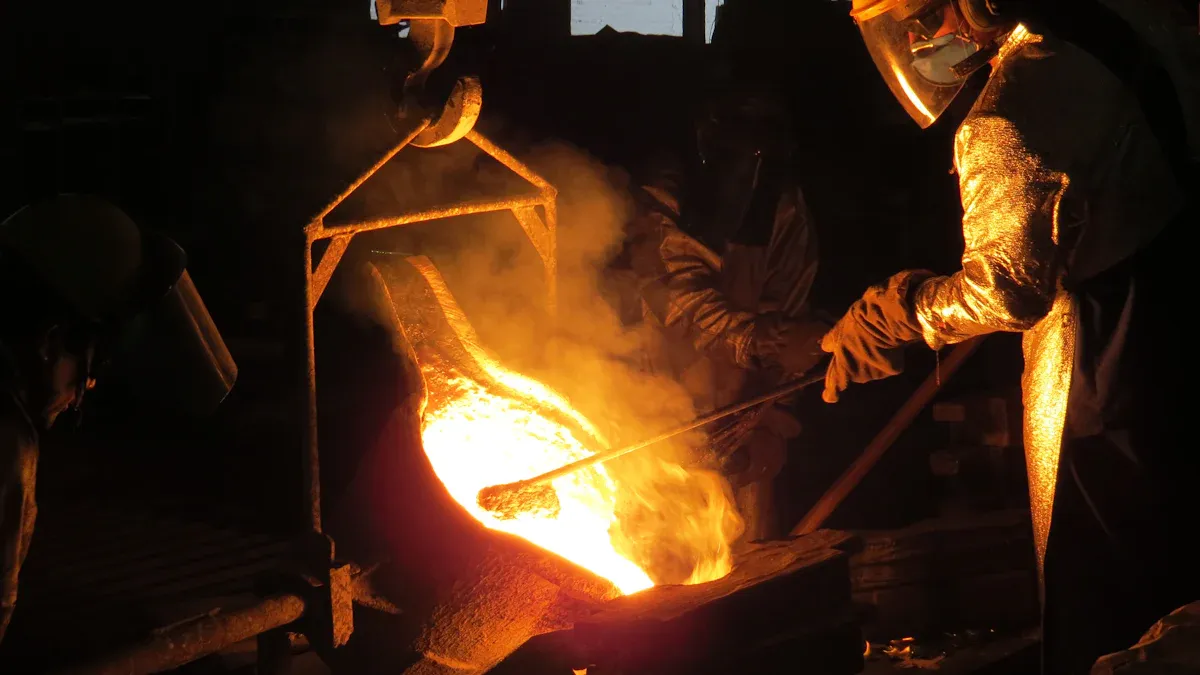The Cost and Precision Benefits of Investment Casting Today

Investment Castings in Precision Engineering& Metal Fabrication play a vital role in producing intricate components with exceptional dimensional accuracy and surface finish. Unlike sand casting, which struggles with detail, or die casting, which limits material options, Investment Castings in Precision Engineering excel in creating complex parts. Modern techniques, such as advanced mold materials and coatings, further enhance the efficiency ofInvestment Castings in Metal Fabrication while reducing waste and machining costs. Industries such as aerospace and automotive increasingly rely on Precision Engineering & Metal Fabrication methods like these for their unmatched precision and cost savings.
Key Takeaways
- Investment casting is very precise, perfect for aerospace and medical fields needing detailed designs and exact measurements.
- It saves money for small batches and prototypes by using less material and needing less machining work.
- This method works with many materials, letting makers customize parts for different uses, making it useful in many industries.
Investment Castings in Precision Engineering & Metal Fabrication

Defining Investment Casting
Investment casting, also known as Lost Wax Casting, is a manufacturing process used to create precise and intricate metal components. It involves creating a disposable wax pattern that matches the final product's shape. This pattern is coated with a ceramic material to form a mold. Once the wax is melted away, molten metal is poured into the cavity, creating a highly detailed and accurate casting.
| Principle | Description |
|---|---|
| Pattern Creation | A disposable pattern (typically wax) is created in the exact shape of the desired final product. |
| Investment | The pattern is coated or 'invested' with refractory material. |
| Pattern Elimination | The pattern is melted or burned out, leaving a negative impression. |
| Casting | Molten metal is introduced into the cavity. |
| Finishing | The investment is removed, and the casting is finished. |
This process is widely used in industries requiring precision, such as aerospace and medical fields, due to its ability to produce complex geometries with minimal waste.
The Investment Casting Process
The investment casting process involves several steps to ensure precision and quality. Here's a simplified breakdown:
- Create a wax pattern.
- Assemble the wax patterns into a tree-like structure.
- Coat the assembly with a ceramic slurry.
- Apply stucco (fine sand) to the wet coating.
- Repeat the coating and stuccoing process to build a strong shell.
- Melt the wax out of the shell (dewaxing).
- Pour molten metal into the cavity.
- Allow the metal to cool and solidify.
- Break the ceramic shell to reveal the casting.
- Cut off individual castings from the tree.
- Finish and test the final product.
This step-by-step approach ensures high repeatability and precision, making it ideal for mass production.
Materials Commonly Used
Investment casting supports a wide range of materials, each offering unique benefits:
- Stainless Steel: Known for its strength and corrosion resistance, it’s perfect for medical devices and marine applications.
- Carbon Steel: A cost-effective option for automotive and heavy machinery parts, though it requires protective coatings.
- Nickel Alloys: With excellent resistance to heat and corrosion, these are commonly used in aerospace and chemical industries.
This versatility allows manufacturers to choose materials that best suit their application needs.
Applications in Precision Engineering
Investment castings play a crucial role in precision engineering across various sectors:
| Sector | Applications |
|---|---|
| Aerospace | Control systems, engine components, structural components |
| Automotive | Engine parts, chassis, suspension components, transmission systems |
| Medical | Implants, surgical instruments, diagnostic equipment |
| Military | Mission-critical equipment, vehicular parts, advanced weapon systems |
| Oil and Gas | Drilling tools, offshore structures, complex pipelines, refinery hardware |

The aerospace sector alone has seen a 31% increase in demand for investment castings, driven by the need for high-precision components like turbine blades. Similarly, the medical field relies on this method for implants and surgical tools, ensuring both accuracy and reliability.
Advantages of Investment Casting
Superior Precision and Dimensional Accuracy
Investment casting offers unmatched precision, making it a go-to method for creating intricate metal components. The process ensures tight tolerances and exceptional dimensional accuracy, which is crucial for industries like aerospace and medical manufacturing. Unlike other methods, such as sand casting, investment casting produces parts with smooth surfaces and minimal defects. This precision reduces the need for extensive machining, saving both time and resources.
For example, turbine blades used in jet engines require exact specifications to ensure optimal performance. Investment casting delivers these high-precision components with ease, meeting the stringent demands of such applications. Manufacturers rely on this method to achieve consistent quality, even for the most complex designs.
Cost-Effectiveness for Complex Designs
Creating complex designs often comes with a hefty price tag, but investment casting changes the game. Its ability to produce intricate shapes in a single process eliminates the need for multiple manufacturing steps. This efficiency translates to significant cost savings, especially for small production runs or prototypes.
Additionally, the process minimizes material waste. By using wax patterns and ceramic molds, manufacturers can precisely control the amount of metal required. This not only reduces costs but also supports sustainability efforts. Companies looking to balance quality and affordability often turn to investment casting for its cost-effective approach to complex designs.
Versatility in Material and Design Options
Investment casting stands out for its versatility. It accommodates a wide range of materials, from stainless steel to nickel alloys, allowing manufacturers to tailor components to specific applications. This flexibility makes it a preferred choice across industries, including automotive, aerospace, and even jewelry.
Investment casting is known for its ability to create parts with superior surface quality, precise dimensions, and intricate shapes. This method allows for the production of complex, highly detailed, and dimensionally accurate components, making it a cornerstone in industries such as aerospace, automotive, and jewelry.
The design possibilities are equally impressive. Whether it’s a lightweight component for an aircraft or a decorative piece for luxury goods, investment casting delivers. Its ability to produce intricate geometries with minimal post-processing sets it apart from other fabrication techniques.
The investment casting process involves creating a wax pattern of the desired part, coating it in ceramic, melting away the wax, and pouring molten metal into the ceramic mold. This multi-step process enables the production of intricate metal components with minimal post-processing.
Reduced Waste and Minimal Post-Processing
Sustainability is a growing concern in manufacturing, and investment casting addresses this by reducing waste. The process uses near-net-shape manufacturing, meaning the final product closely matches the desired dimensions. This minimizes the need for additional machining, which often generates excess material.
A comparison of manufacturing processes highlights the environmental benefits of investment casting:
| Manufacturing Process | Greenhouse Gas Emissions | Recycled Material Usage |
|---|---|---|
| Forged Steel | Lowest | Highest |
| Cast Aluminum | Higher | Lower |
| Cast Iron | Highest | Lower |
Investment casting strikes a balance between precision and sustainability. By using wax patterns and recyclable materials, it reduces the environmental footprint of production. Manufacturers benefit from lower material costs and less waste, making it an eco-friendly choice for high-quality components.
Comparing Investment Casting with Other Metal Fabrication Techniques

Investment Casting vs. Die Casting
Investment casting and die casting are both popular methods for producing metal components, but they serve different purposes based on precision, volume, and cost.
| Investment Casting | Die Casting | |
|---|---|---|
| Tolerance | +/-0.005 inches | Standard: +/-0.010 inch, Precision: up to +/-0.002 inch |
| Cycle Time | Hours per casting | Up to 100 shots per minute |
| Production Volume | Less than 10,000 pcs | Over 10,000 pcs |
Die casting excels in high-volume production due to its rapid cycle times. Manufacturers can produce hundreds of parts per hour, making it ideal for industries like automotive and consumer electronics. However, this speed comes at a cost. Die casting requires expensive tooling, which makes it less suitable for small production runs.
On the other hand, investment casting shines in low-volume production and intricate designs. It achieves a smoother surface finish, averaging 125 Ra, and holds a tolerance of .005”/inch. This precision reduces the need for post-casting machining, saving time and resources. While die casting offers tighter tolerances in some cases, investment casting is better for reproducing complex geometries and fine details.
Tip: If your project involves high-volume production with simpler designs, die casting might be the better choice. For low-volume runs or intricate components, investment casting is the way to go.
Investment Casting vs. Sand Casting
Sand casting and investment casting differ significantly in terms of precision, cost, and application.
| Casting Method | Advantages | Disadvantages |
|---|---|---|
| Sand Casting | Low cost, material versatility, short lead time, low tooling costs | Lower strength, low dimensional accuracy, labor-intensive, higher defect rates |
| Investment Casting | High precision, superior surface finish, material diversity | Higher costs, longer production cycles, size limitations |
Sand casting is known for its affordability and ability to produce large components. It’s commonly used in construction and infrastructure projects, where dimensional accuracy is less critical. However, sand casting often results in rough surfaces and requires extensive machining to meet tighter tolerances.
Investment casting, by contrast, delivers exceptional precision and a superior surface finish. It’s ideal for industries like aerospace and medical, where accuracy and reliability are paramount. For example, turbine blades in jet engines rely on investment casting to meet strict performance standards. While the process is more expensive and time-consuming, the results justify the investment for high-value applications.
Note: Sand casting is a good option for large, simple parts. For smaller, intricate components requiring high precision, investment casting is the better choice.
Investment Casting vs. CNC Machining
CNC machining and investment casting both offer high levels of precision, but they cater to different needs.
Investment casting excels in producing intricate parts with complex geometries. The process allows manufacturers to create near-net-shape components, reducing the need for extensive machining. This makes it particularly advantageous for applications like aerospace and automotive, where lightweight, detailed designs are essential.
CNC machining, on the other hand, is highly versatile and precise. It’s perfect for creating prototypes or parts with extremely tight tolerances. However, machining intricate designs can be time-consuming and costly, especially when removing large amounts of material. Investment casting eliminates this issue by shaping the component during the casting process itself.
While CNC machining is unmatched for prototyping and custom parts, investment casting is more efficient for mass-producing intricate designs with minimal waste.
Investment Casting vs. Forging
Forging and investment casting are both used to create durable metal components, but they differ in their approach and the properties of the final product.
| Process | Key Characteristics | Impact on Component Integrity |
|---|---|---|
| Investment Casting | High precision, complex shapes, suitable for aerospace | Critical for intricate designs and specifications |
| Forging | Enhanced mechanical properties, toughness, fatigue resistance | Essential for high-stress applications |
Forging is renowned for its strength and durability. The process involves shaping metal under high pressure, which aligns the grain structure and improves mechanical properties. This makes forging ideal for high-stress applications like crankshafts and connecting rods in engines.
Investment casting, however, offers greater design flexibility. It can produce complex shapes that forging cannot achieve. For example, components with internal cavities or intricate geometries are better suited for investment casting. While forging provides superior toughness, investment casting ensures precision and detail, making it indispensable for industries like aerospace and medical.
Tip: Choose forging for parts that need maximum strength and fatigue resistance. Opt for investment casting when precision and intricate designs are more important.
When Investment Casting Is the Optimal Choice
Scenarios Requiring High Precision
Investment casting shines when precision is non-negotiable. It’s the go-to method for creating geometrically complex parts with fine details and tight tolerances. Industries like aerospace and medical rely on this process to produce components that meet strict technical requirements. For example, turbine blades in jet engines demand exceptional dimensional accuracy to ensure optimal performance.
- Key Benefits:
- Produces parts with smooth surfaces and minimal defects.
- Reduces the need for post-casting machining, saving time and resources.
- Ideal for intricate designs requiring high precision and reliability.
This method allows manufacturers to achieve consistent quality, even for the most challenging designs. Whether it’s a lightweight medical implant or a high-performance automotive part, investment casting delivers results that meet the highest standards.
Cost Considerations for Prototypes and Small Runs
Investment casting offers a cost-effective solution for prototypes and small production runs. While the initial tooling costs may seem high, the process minimizes material waste and reduces the need for extensive machining. This makes it an economical choice for manufacturers working on intricate designs.
| Casting Method | Advantages | Cost Implications |
|---|---|---|
| Investment Casting | Ideal for intricate designs with tight tolerances. | Higher initial costs but economical for high-precision parts. |
| Sand Casting | Viable for larger parts or lower production volumes. | Generally lower costs but less precision. |
| Centrifugal Casting | Suitable for specific applications requiring less complexity. | Cost-effective for certain shapes but limited in detail. |
Rapid prototyping (RP) further enhances cost efficiency. By reducing lead times for tooling, RP allows manufacturers to quickly develop prototypes and complex components. This approach is particularly beneficial for industries like automotive, where speed and accuracy are critical.
Tip: Investment casting is perfect for small runs where precision outweighs volume. It’s a smart choice for manufacturers looking to balance quality and affordability.
Industries Benefiting from Investment Casting
The aerospace and military sectors benefit the most from investment casting. This method produces lightweight, high-precision components that meet stringent performance standards. Turbine blades, engine casings, and structural parts are just a few examples of its applications in aerospace.
In the defense industry, investment casting ensures reliability and safety for mission-critical equipment. Components like weapon systems and vehicular parts require durability and precision, making this method indispensable.
Other industries, including medical and automotive, also rely on investment casting. Medical implants and surgical tools demand accuracy and biocompatibility, while automotive manufacturers use this process for engine parts and transmission systems. Investment casting’s versatility makes it a cornerstone in sectors where quality and complexity matter most.
Investment casting delivers unmatched precision, cost savings, and design flexibility. Manufacturers can create intricate shapes that other methods struggle to achieve. Its ability to minimize waste and recycle materials makes it both cost-effective and eco-friendly.
| Advantage | Description |
|---|---|
| Versatility | Creates complex shapes and intricate designs that other processes cannot replicate. |
| Cost-Effectiveness | Economical for large quantities, with reusable molds extending production value. |
| Precision and Accuracy | Ensures tight tolerances, ideal for high-performance components. |
| Minimal Waste | Recycles excess material, reducing costs and environmental impact. |
Manufacturers should evaluate their project requirements carefully. For intricate designs and high-quality output, investment casting often proves to be the best choice.
FAQ
What industries benefit the most from investment casting?
Industries like aerospace, medical, and automotive benefit greatly. They rely on investment casting for its precision, ability to create intricate designs, and material versatility.
How does investment casting reduce waste?
Investment casting uses near-net-shape manufacturing. This minimizes excess material and reduces the need for machining, making it an eco-friendly and cost-effective process.
Can investment casting handle large production volumes?
Yes, but it’s more cost-effective for small to medium runs. For high-volume production, methods like die casting may offer better efficiency.
Tip: Evaluate your production needs to choose the right casting method.















